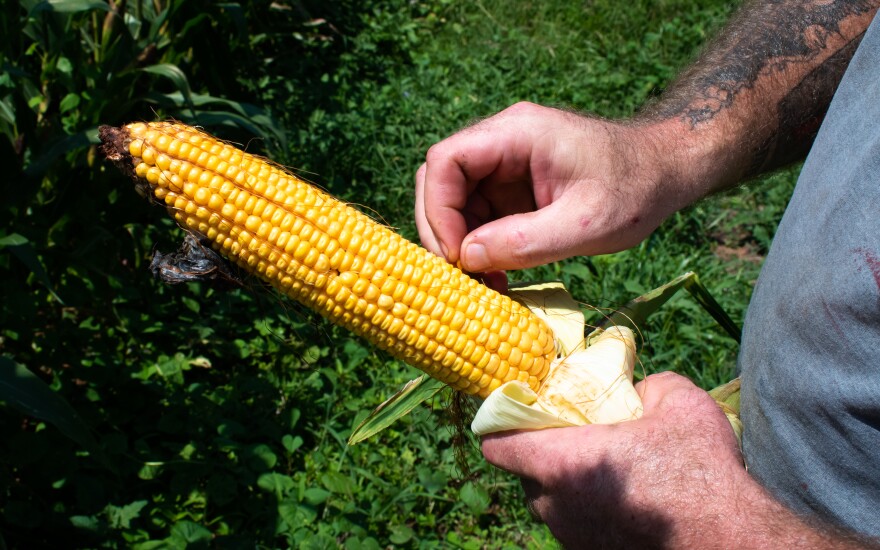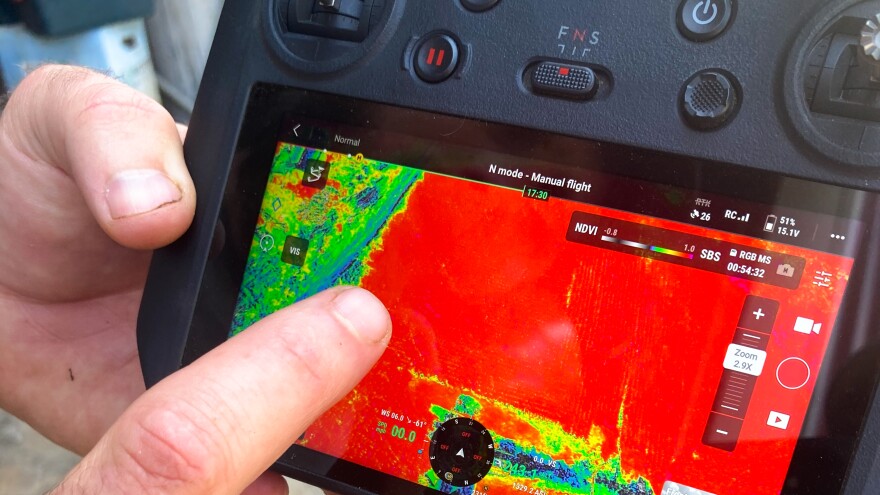Russell Hedrick’s farm sneaks up on you. One moment, you’re rolling through the back of a neighborhood in east Hickory. The next, you’re behind a barn, looking over 12 acres of corn rolling over a hill, squeezed between quaint, brick bungalows and ranch-style houses.
Hedrick breaks off an ear of corn from a seven-foot-tall stalk at the edge of his field.
“You can see they’re just starting to dent,” Hedrick said, pointing out a small indentation. “I would say this corn will be ready … first of October.”
A severe drought in June coincided with a critical moment for the state’s corn crop. Ron Heiniger works with corn farmers across the state through the N.C. State Extension Office. He said the state averaged 150 bushels per acre last year. Heiniger said farmers are expecting half that this year.
“We’ve had some fields where we’ve harvested 30 bushels to the acre,” Heiniger said. “If they got a lucky little shower — or their soil was better, held on a little longer — we got some 120, 130-bushel corn yields.”
Many farmers were less lucky, especially closer to the coast, where the sandy soils lose moisture faster. The drought wiped out entire fields — the leaves dried out, and the plants never pollinated.
Hedrick said he’s expecting closer to 140 or 150 bushels of corn. The key, Hedrick said, is focusing on soil health.
“Everything that we’re looking at — water, air, human health, nutrient density of our crops — all of that ties back to the soil.”

Russell Hedrick is expecting 140 to 150 bushels of corn per acre on his farm in Catawba County.
Taking a peek under Earth’s hood
To be fair to farmers in the Coastal Plains of North Carolina, the soil where Hedrick lives is built a little differently. For one, a higher clay concentration in the soil helps retain water between rains.
But Hedrick has also played a role in fortifying his soil against climate impacts, like drought. After harvest time, he plants his fields with a blend of grasses and other non-commodity crops, called cover crops. They lock down the soil to prevent erosion and return organic carbon to the ground when they die.
“The more carbon in the soil we have, the more water the soil can store,” said Bright Ofori, a soil scientist for the North Carolina Department of Agriculture. “The soil becomes more resistant to getting eroded by wind or by rainfall.”
That extra moisture helped Hedrick’s crops weather this year’s drought. The USDA estimates that every 1% increase in organic matter holds 25,000 more gallons of water per acre.
Tools like cover crops and no-till farming fall under the loose umbrella of techniques labeled regenerative agriculture. The USDA’s Natural Resources Conservation Service helps farmers implement some regenerative practices through the Environmental Quality Incentives Program, or EQIP grant. Lee Holcomb administers this program and others in North Carolina.
He said that while the exact definition of regenerative agriculture might vary depending on who you ask, there are some common themes.
“You’re working with nature to build more resilient soils and still have — if you’re talking about row crops — a commodity to sell and remain profitable,” Holcomb said.
When Hedrick started farming over ten years ago, he reached out to Lee Holcomb to learn more about row cropping. Holcomb turned Hedrick on to cover crops.
Hedrick received an EQIP grant in 2012. It gave him some breathing room to experiment with different types of cover crops. His first blend of grasses took off immediately — perhaps a little too well.
“I’m six-foot-five. Russell’s like six-foot-three,” Holcomb said. “[The grass] was as tall as us. And [Hedrick] said, ‘Okay, Mr. Conservation, what we going to do about this?’
I said, ‘Man, it’s a great problem to have.’”
Hedrick has since solved that problem using a crimper to fold the grasses over. He then seeds his crops in the flattened beds, which in turn grow through the decomposing plant matter.
Teaching an old trade new tricks
Cover crops as a concept are nothing new. Indigenous communities around the world have practiced some version of cover crops for millennia. But Hedrick is also embracing new tech to monitor and improve soil health.
In the barn, Hedrick fired up a small drone. It shot up above the barn and zipped over the cornfield. A small camera fed information to a monitor on Hedrick’s controller.
“Now, you can see we had really good nitrogen here,” Hedrick said.
He pointed to the display. The readout looks infrared, but it’s more like infra … green. The drone’s camera detects the amount of green light reflected off his crops. On the monitor, the field appeared as a mostly red blob with orange striations.

The drone picks up the green light reflected off Hedrick’s corn. This information helps him spot-treat his crops with fertilizers.
“That hillside is just a little bit low, but it’s not that’s not enough to treat anything,” Hedrick said.
He said that without this technology, past farmers would overtreat their farms — applying fertilizer to a much greater area than what was actually needed.
“Instead of them treating that one little half acre, they would have put nitrogen on the whole 12 acres,” Hedrick said.
When Hedrick uses fewer inputs, it saves him money and reduces the runoff that comes from his farm. By improving his overall soil health, Hedrick can keep both the water and fertilizer in his fields, which is exactly where he and the surrounding community want it.
Farming in a warming world
Droughts similar to what North Carolina experienced in June are predicted to become more common as the climate warms. When I spoke to Klaus Albertin, chair of the N.C. Drought Management Advisory Council, in July, he described it as a weather “roller coaster effect.” As fossil fuel combustion releases more carbon pollution into the atmosphere, yearly rainfall will happen during more extreme events.
After heavy rains in April, North Carolina dried rapidly in June. Normally, North Carolina expects about four to five inches during that time of year.
“Another week went by; sometimes we didn’t get any rainfall,” Albertin said. “Sometimes stations got maybe a quarter of an inch.”
When it comes to North Carolina’s climate, global warming is stacking the deck in favor of extreme weather events. However, Hedrick said that when he thinks about climate change, it’s more about the role agriculture can play in reducing carbon pollution in the atmosphere.
The federal government invested $19.5 billion for farmers to practice “climate-smart” agriculture. Funding for EQIP, the program that got Hedrick started with cover crops, has more than doubled in N.C. following the Inflation Reduction Act, according to USDA conservationist Lee Holcomb.
Beyond carbon sequestration, farmers can also help by using less. Agriculture in the U.S. constitutes 15% of total natural gas demand in the country, according to the American Gas Association. Most of that gas is used to make fertilizers and other agrochemicals.
When farmers like Hedrick focus on improving overall soil health, their fertilizer use declines. Not only does this reduce the carbon pollution associated with his farm, it better positions him for future extreme weather events.
“We’re essentially trying to make our ground resilient,” Hedrick said. “So that when we do have these climate events, and we’re not seeing rainfall or too high of heat, we have stress mitigation in the ground already.”
Source link : http://www.bing.com/news/apiclick.aspx?ref=FexRss&aid=&tid=66e25115efdd4499879e715b8c68d082&url=https%3A%2F%2Fwww.wunc.org%2F2024-09-11%2Fnorth-carolina-corn-farmer-uses-new-tech-and-old-techniques-to-weather-drought&c=11527206095938811835&mkt=en-us
Author :
Publish date : 2024-09-11 15:17:00
Copyright for syndicated content belongs to the linked Source.







